
The Big Egyptian Sphinx Cover Up: Hidden Chambers, An Unexcavated Mound and Endless Denial
In 1935, Egypt was still the main draw for archaeologists digging for answers. It was hardly more than a decade since the British Egyptologist Howard Carter discovered the tomb of Tutankhamen on November 4, 1922, that had lain nearly undisturbed for over 3,000 years. Yet that is another amazing story still to be investigated. However, right now, our attention is focused on the latest attempt to hide the real ancient history of an unknown civilization that left us with great wonders both above and below the sands of the Giza Plateau.
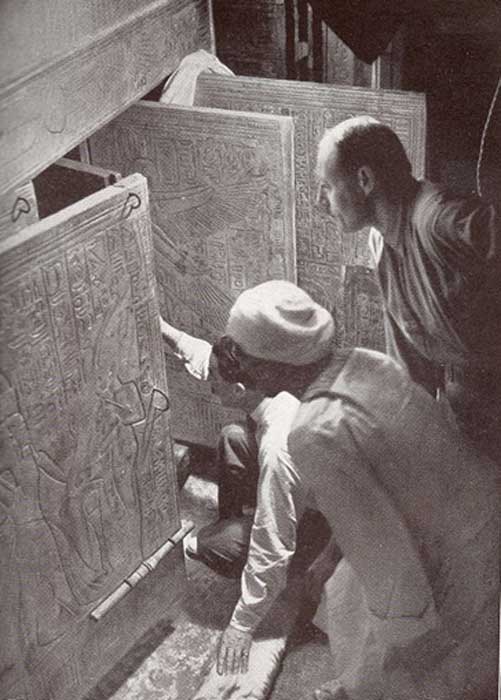
The moment Howard Carter opens the tomb of Tutankhamun (public domain)
Ancient Lost City Unearthed in Egypt
The first news of a ‘Secret City’ hit the World Press in the first week of March 1935. By July of that year, much more had been found and the Sunday Express ran an article by Edward Armytage who had just returned to England from Egypt where he had watched the excavation of an ancient Egyptian city that was then thought to date back 4000 years.
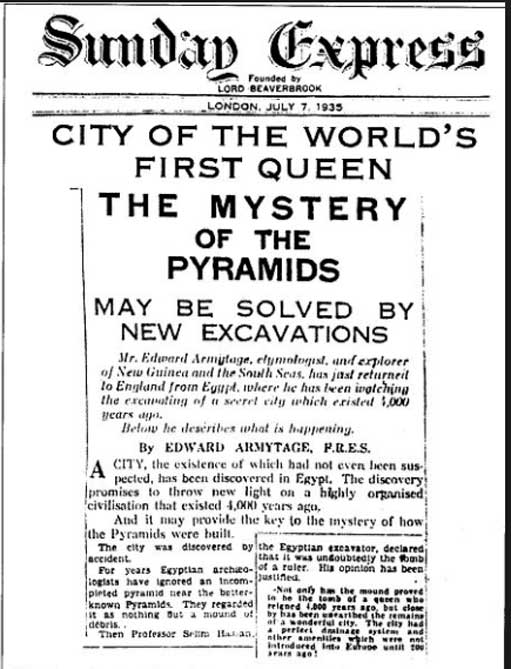
The unearthing of a lost city in Egypt was reported in many papers in 1935, including this report in the Sunday Express on 7 July, 1935 (public domain)
Media Silence
…….then came silence, as if every living Egyptologist had lost all interest in this wonderful underground metropolis. All their articles during the ensuing years were centered on tombs of queens and shafts that had sunk deep into the ground to burial tombs some time during the 24th Dynasty, which was as late as 732 BC to 716 BC. It is very odd that such an immense discovery of a whole underground city dating back at least 4,000 years was ignored completely in favor of a late period Dynasty that almost passed without notice.
Denial of Previous Discoveries
That was some eighty years ago and today we have come up against a similar ‘rose granite block wall’, in the person of the former Minister of State for Antiquities Affairs, Zahi Hawass, who held that position until Egypt’s revolution in 2011 that toppled Hosni Mubarak—and also ended Hawass’ controversial reign as the supreme chief of all Egypt’s antiquities. However, he still has his ‘finger in the pie’ so to speak. Much has been written about the Egyptian ‘Indiana Jones’ who presents a big smile at one moment but red-raged faced the next when any unwelcome question is posed to him. This side of his character is well documented in Robert Bauval and Ahmed Osman’s book “Breaking the Mirror of Heaven”.
However, such a temperament doesn’t duly explain why Zahi Hawass has so publicly announced that there is nothing at all below the Sphinx, neither any tunnel nor a single chamber, when there have many photos of him entering descending shafts from the head of the Sphinx and another at the far rear of the Lion Body. Are we supposed to forget completely what we have seen several times in the past and accept such denials without question?
Statements Contradict Photographic Evidence
Apparently, he brushed off such enquiries of hidden tunnels under the Giza Plateau and chambers under the Sphinx by saying that it wasn’t possible to look deeper, as the chambers were either blocked or full of water. That may well be the case, though we can see from one of the photos showing a rear downward shaft from the side of the Sphinx that the floor far below is quite dry.
We do know that Hawass had climbed down ladders from the rear entrance of the Sphinx, into a deep chamber on a middle layer and then even further down to a bottom chamber which apparently contained a very large sarcophagus and that was filled with water, as these scenes are all in a documentary film made by Fox. It is hard to imagine how he could possibly think that he could later deny all that he had earlier accomplished.

Zawi Hawass descending down a shaft towards a chamber filled with water that contained a large sarcophagus. Credit: Fox
A Hole in the Sphinx’s Head
Around 1798, Vivant Denon etched an image of the sphinx, although he hadn’t copied it that well. However, he no doubt knew that there was a hole on the top of its head as he had drawn an image of a man being pulled out.
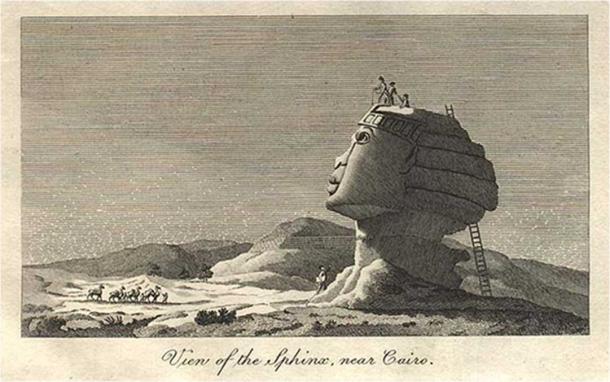
Vivant Denon’s sketch of the sphinx in 1798 depicts a man being pulled out of a hole in the sphinx’s head (public domain)
A sketch can hardly be used as proof, but in the 1920’s an aerial photo of the sphinx taken from a hot air balloon showed that there is such an opening on the top of its head.
- Depicting Man or Beast: Can you Solve the Riddle of the Great Sphinx of Giza?
- A Forgotten Sphinx and Faked Cartouche: Changing the Course of Ancient Egyptian History?
- 36,400 BC: The Historical time of the Zep Tepi Theory
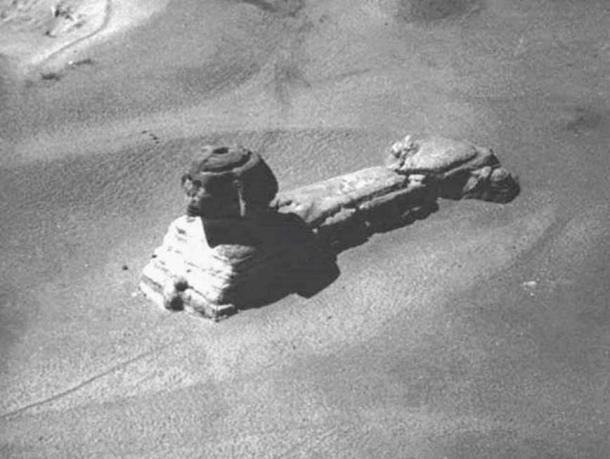
1920s aerial photo shows a hole in the sphinx’s head (Public domain)
The Enigma of the Sphinx’s Head
It seems quite clear from the totally different construction materials and color of the Sphinx head, which we believe is not rock, but some type of man-made substance compared to its limestone and eroded body, that the head and face of the Sphinx must have been changed from its original shape long after the monument was first carved. There is hardly any erosion to the head compared to its body.
The sides of the headdress are quite smooth and we only need glance at the mythical creature to spot the lighter color of the body compared to the darkness of the head.
According to Tony Bushby in his “The Secret in The Bible” a badly fragmented Sumerian cylinder tells a tale that could easily be taken as having happened at Giza and involving a beast that had a lion head with a tunnel entrance hidden by sand. Everything now points to the Sphinx body having been sculpted out of natural stone when there was frequent heavy rainfall and that takes us back to about the same time that Robert Bauval and Robert Schoch have calculated for the construction of the Orion’s Belt Pyramids, i.e. circa 10,450 BC.
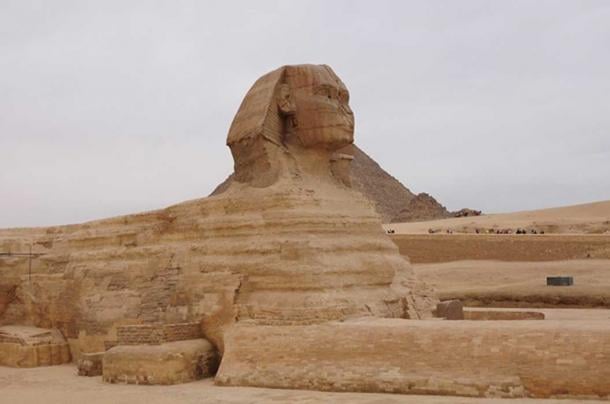
The head of the sphinx appears to be made from different material to the rest of the body, and does not show the same level of erosion as the rest of the body (CC by SA).
Two Sphinxes?
There have been sketches of the Giza (the word Gisa in Ancient Egyptian means ‘Hewn Stone’) complex from as far back as 1665 and some do show two heads peering out of the sands, one usually having female features.
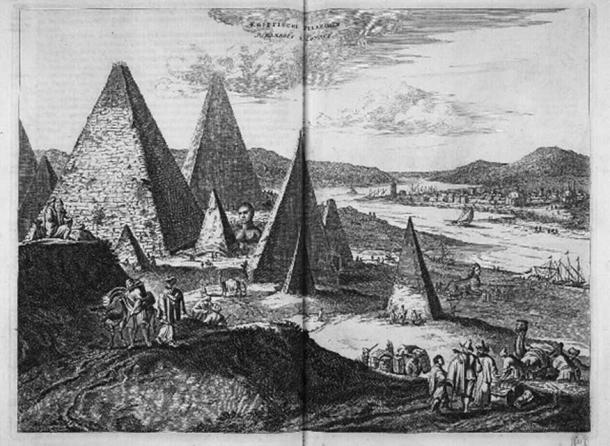
The Great Sphinx of Giza in Olfert Dapper, Description de l'Afrique (1665)- note the depiction of two sphinxes (public domain)
It was an ancient Egyptian practice to inscribe two lions, which they called Akerw, next to their doorways for heavenly protection and that would lead us directly to a mound near the sphinx, which Gerry has identified and measured. Could this mound contain the buried body of a second sphinx?
Read more on this theory here: A Forgotten Sphinx and Faked Cartouche: Changing the Course of Ancient Egyptian History?
One would have thought that this mysterious, large, covered shape so close to the sphinx would have been greeted with great enthusiasm by the Egyptian authorities, yet Hawass and Mark Lehner didn’t want to listen to his theory, according to a reliable source.
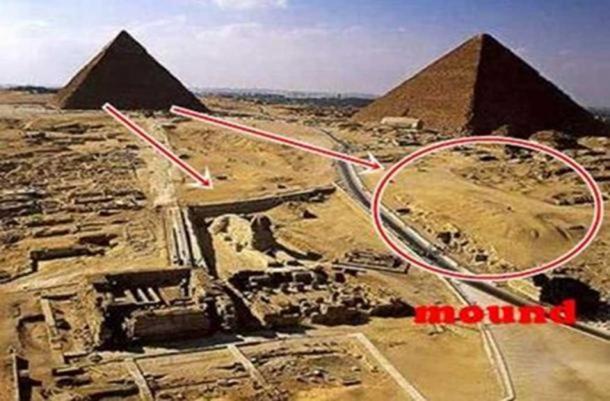
Giza Plateau with proposed buried second sphinx mound encircled. (Travel Around the World)
Gerry had contacted someone in a renowned institute in Cairo that had equipment that could detect objects under the sand. That person applied for a permit to the then Supreme Council of Antiquities to investigate the mound, but they didn’t respond. Apparently, no one else was granted a license to investigate the specific area of the mound where we believe a Second Sphinx could be unearthed. No doubt they had a reason for it!
Why the Denial?
Why would those two Egyptologists be so alarmed by the suggestion that there was something that had been missed for centuries? Is it possible that they don’t want to reveal something beneath that mound? It isn’t reasonable that anyone should have so much objection to any kind of probe or even a simple aerial photograph being taken, which might lead to the discovery of yet another amazing wonder of the world and a wonder that would draw many more thousands of tourists to Egypt. They won’t even admit to ever having examined the mystery mound themselves, and surely had this been done they would be the first to say so.
A few years ago, Zahi Hawass met the Foreign Press Association in Cairo to vent his frustration with a group of pseudo-scientists whose personal attack, through television and other media, had escalated to the point where it had become threatening. Apparently, he was worried that a NBC interview would support and publicize their ideas, which he suggests were purely for personal gain.
He apparently said in a statement:
"I want to talk about things that do not make any sense,”
His gesture expressed his increased frustration with what he commonly classified as "pyramidiots" - those with views greatly at variance with the established scientific community.
"They are saying secret excavations…are going on around the Sphinx and are not being revealed. This is definitely not so."
Zahi Hawass is not only a great showman and probably the most knowledgeable man in the world about ancient Egypt, he has also achieved a lot to promote tourism for his country. However, he appears to have an agenda, and that is to keep in place the conventional understanding of ancient Egyptian history, no matter how many new findings contradict what is currently believed to be true.
Top image: Vivant Denon’s sketch of the sphinx in 1798 depicts a man being pulled out of a hole in the sphinx’s head (public domain)
By Malcolm Hutton & Gerry Cannon, co-authors of the forthcoming book “The Giza Plateau Secrets and a Second Sphinx Revealed”. Read more about the second sphinx and Gerry 's quest for the Ark of the Covenant at: www.gerrysarkquest.com
Updated on May 21, 2021.
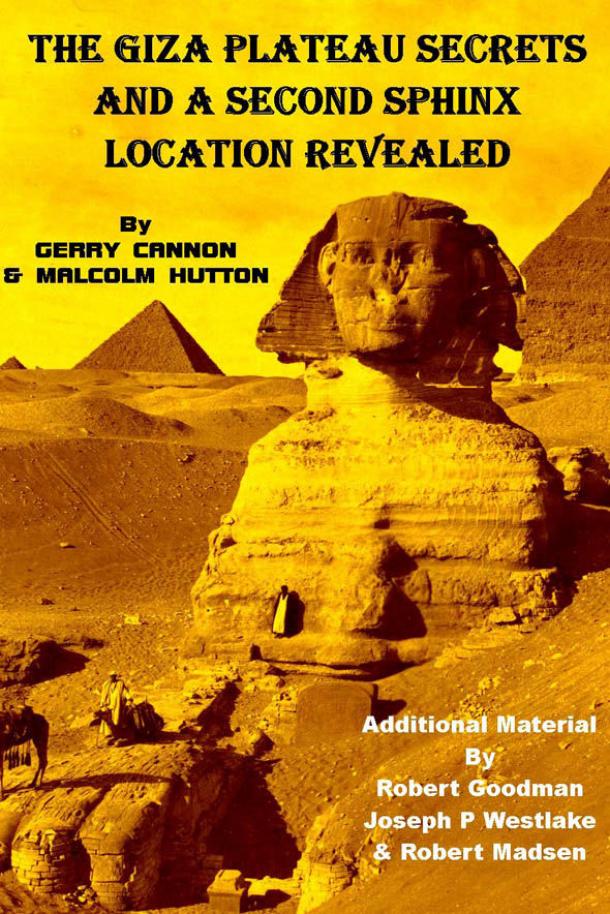
















Comments
The key to understanding the purpose of the pyramid complex structures lies under it. It’s been investigated, and there is some relatively primitive (compared to the top part) stonework around a ground water well-spring deep below. Their idea was to create a gravity effect to pull water from below, and the pyramid itself seems to have been progressively built to perpetuate this function, possibly as the water table otherwise could not support to demand of a growing population. The hole in the Sphinx head may have been a huge water fountain. Just imagine it, a huge stone entity, water flowing all around it, kids swimming joyfully. A beautiful vision, not to mention some great caveman engineering. The complexes surrounding the pyramids might have been huge communal bathhouses. The whole idea of ‘elites’ creating these stoneworks for themselves (for tombs, etc.) is just utter non-sense, to have us accept the modern, dubious idea of ‘elites’ as distinct from commoners. Ancient Egypt, prior to the Ice Age (long nuclear winter) represented the ‘golden age’, when all was good and peaceful, and men were just men (no elite/tyrant types). Of course, Hawass is a big trickster, like his type in general, but his smirking face could be the poster child for them all.
Nobody gets paid to tell the truth.
Be aware that some drawings in old books are very much “artist’s impressions”, drawn by people who were never at Giza.
Seems like a hit piece …. But what eves gets the rabble stirred
Just reading the article title with the word DENIAL I chuckled because I just knew this would be about Hawass. Hawass is no longer a scientist or even professional archeologist. He’s a pompous overbearing ABSOLUTIST who continues to force his opinions and control with the theory that his view is the ABSOLUTLEY only view there can be and he sees himself as the keeper of the secrets. He seeks power. He has become the Grand Vizier of Deceit.
I had hoped that he was gone for good but alas and alack, he’s back.
Need2Knw
Funny!
GLVJR
Pages